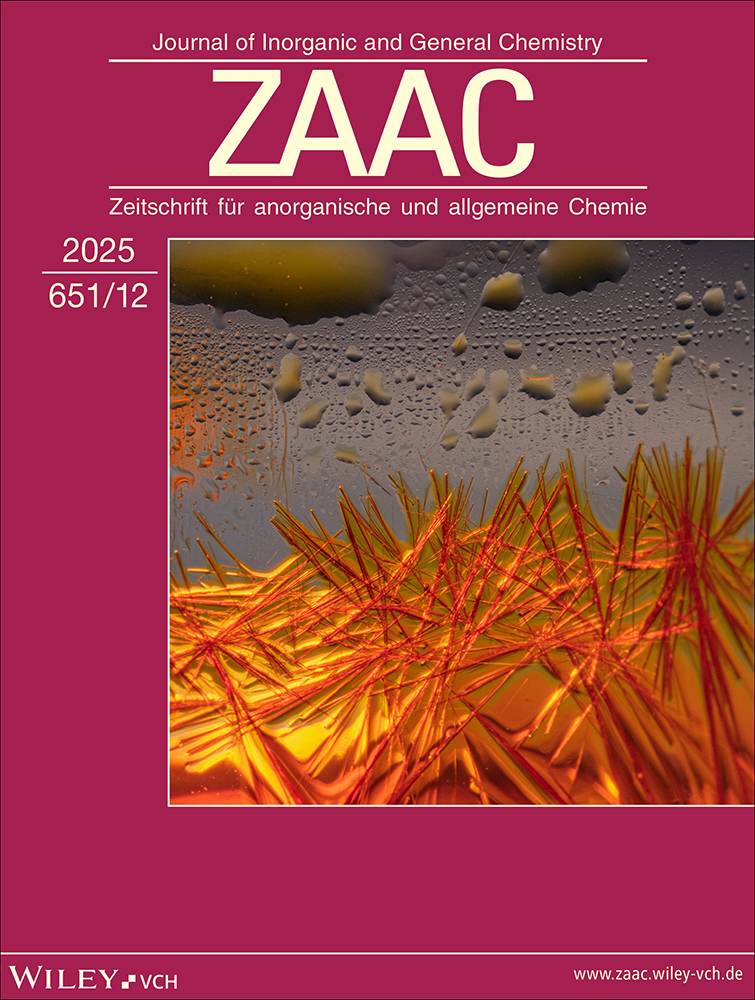Alternativ-Liganden. XXXII [1]. Neue Tetraphosphan-Nickelkomplexe mit Tripod-Liganden des Typs XM′ (OCH2PMe2)n(CH2CH2PR2)3 – n (M′ = Si, Ge; n = 0 – 3)†
Professor Ekkehard Lindner zum 60. Geburtstag gewidmet
Abstract
deTripodliganden des Typs XM′ (OCH2PMe2)n(CH2CH2PMe2)3 – n (M′ = Si, Ge; n = 0 – 3) (1–6, Tab. 1) wurden in Kombination mit PPh3 bzw, PMe3 zur Darstellung neuer Tetraphosphankomplexe des Nickels genutzt. Die Vertreter LNiPPh3 (7 – 12) sind durch Umsetzung von Ni(COD)2 (COD = 1,5-Cyclooctadien) mit den entsprechenden Liganden und PPh3 in Toluol in mäßigen Ausbeuten zugänglich. Die Synthese der Derivate LNiPMe3 (13 – 18) gelingt z. T. (16 – 18) in Analogie zu den Ph3P-Komplexen; die Vertreter 13 – 16 sind in höheren Ausbeuten durch Umsetzung von Ni(PMe3)4 mit den jeweiligen Liganden darstellbar. 13 – 18 lassen sich in der Regel nicht vollständig von Nebenprodukten abtrennen. Der dreikernige Komplex FSi(CH2CH2PMe2)3[Ni(PMe2CH2CH2)3SiF]3 (19) fällt im Gemisch mit 18 bei der Reaktion von Ni(COD)2 mit 6 und PMe3 an. Die neuen Verbindungen wurden (wenn möglich) durch analytische (C, H), generell aber durch spektroskopische Untersuchungen (IR; 1H-, 13C-, 19F-, 31P-NMR; MS) charakterisiert. Auf eine schwache, aber signifikante Ni → Si-Wechselwirkung durch den Käfig weisen folgende Befunde hin: (1) Die großen Tieffeldverschiebungen δδF von 35,2 ppm (12), 38,3 ppm (18) und 37,7 ppm (19); (2) 6J(PF)-Kopplungen [bzw. 3J(PNiSiF) durch den Käfig] von 6,0 Hz (12) und 7,6 Hz (18) sowie die Tieffeldverschiebung δδSi von 12,8 ppm (12); 3) die NiSi-Abstände von 3,95 Å in 7 und 3,92 Å in 12, verbunden mit einer deutlichen Stauchung der Käfige in Richtung der Ni ··· Si-Achse. Eine zusätzliche Entlastung des Ni von der hohen Ladungsdichte erfolgt durch π-Rückbindung zu den Phosphanliganden.
Abstract
enAlternative Ligands. XXXII [1]. Novel Tetraphosphane Nickel Complexes with Tripod-Ligands of the Type XM′(OCH2PMe2)n(CH2CH2PR2)3 – n (M′ = Si, Ge; n = 0 – 3)
Tripod Ligands of the type XM′(OCH2PMe2)n(CH2CH2PMe23 – n (M′ = Si, Ge; n = 0 – 3) (1 – 6, Table 1) have been used together with PPh3 or PMe3 for the preparation of novel tetraphosphane complexes of Nickel. The representatives LNiPPh3 (7 – 12) are obtained by reaction of Ni(COD)2 (COD = 1,5-cyclooctadiene) with the corresponding ligands and PPh3 in toluene in moderate yields. The synthesis of the derivatives LNiPMe3 (13 – 18) is partly (16 – 18) accomplished in analogy to the Ph3P-complexes; compounds 13 – 16 are obtained in higher yields by reaction of Ni(PMe3)4 with the respective ligand. As a rule, 13 – 18 cannot be separated from by-products. The trinuclear complex FSi(CH2CH2PMe2)3[Ni(PMe2CH2CH2)3SiF]3 (19) is formed together with 18 in the reaction of Ni(COD)2 with 6 and PMe3. The new compounds have been characterized (if possible) by analytical (C, H), but in general by spectroscopic investigations (IR; 1H-, 13C-, 19F-, 31P-NMR; MS). A weak, but significant Ni → Si interaction through the cage is indicated by the following results: (i) Large low-field shifts δδF of 35.2 ppm (12), 38.3 ppm (18) and 37.7 ppm (19); (ii) 6J(PF) coupling constants [or 3J(PNiSiF) through the cage] of 6.0 Hz (12) and 7.6 Hz (18) together with a low-field shift δδSi of 12.8 ppm (12); (iii) NiSi distances of 3.95 Å in 7 and 3.92 Å in 12, accompanied by a compression of the cage along the Ni ··· Si axis. An additional release from the high charge density on Ni results from π-backbonding to the phosphane ligands.




